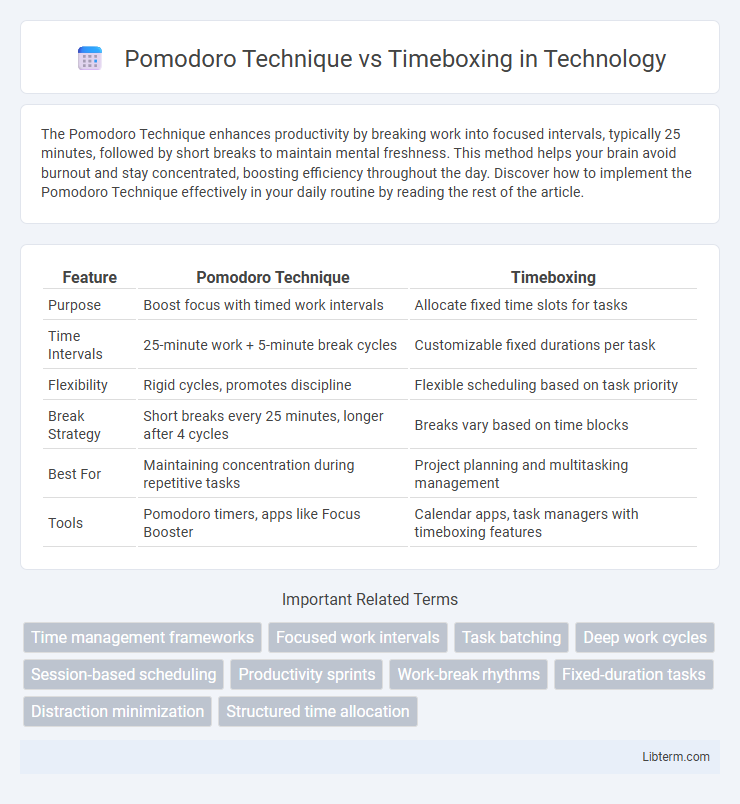The Pomodoro Technique enhances productivity by breaking work into focused intervals, typically 25 minutes, followed by short breaks to maintain mental freshness. This method helps your brain avoid burnout and stay concentrated, boosting efficiency throughout the day. Discover how to implement the Pomodoro Technique effectively in your daily routine by reading the rest of the article.
Table of Comparison
| Feature | Pomodoro Technique | Timeboxing |
|---|---|---|
| Purpose | Boost focus with timed work intervals | Allocate fixed time slots for tasks |
| Time Intervals | 25-minute work + 5-minute break cycles | Customizable fixed durations per task |
| Flexibility | Rigid cycles, promotes discipline | Flexible scheduling based on task priority |
| Break Strategy | Short breaks every 25 minutes, longer after 4 cycles | Breaks vary based on time blocks |
| Best For | Maintaining concentration during repetitive tasks | Project planning and multitasking management |
| Tools | Pomodoro timers, apps like Focus Booster | Calendar apps, task managers with timeboxing features |
Understanding the Pomodoro Technique
The Pomodoro Technique breaks work into focused intervals of 25 minutes, called "Pomodoros," followed by short breaks to enhance concentration and reduce mental fatigue. Timeboxing allocates fixed time periods to tasks but doesn't specify structured breaks or interval lengths. Understanding the Pomodoro Technique involves recognizing its emphasis on cyclical work-rest patterns designed to improve productivity and maintain sustained attention.
What Is Timeboxing?
Timeboxing is a time management method where fixed time periods, or "boxes," are allocated to specific tasks to enhance productivity and prevent task overruns. Unlike the Pomodoro Technique's strict 25-minute intervals, timeboxing offers flexible durations tailored to task complexity and individual workflow preferences. This approach enables clearer prioritization, better focus on high-impact activities, and effective avoidance of procrastination by committing to a set timeframe for each task.
Key Differences Between Pomodoro and Timeboxing
The Pomodoro Technique segments work into fixed 25-minute intervals called "pomodoros," followed by short breaks, optimizing focus and preventing burnout. Timeboxing allocates a set amount of time to a task without strict interval constraints, emphasizing time limits rather than task completion. Pomodoro emphasizes frequent breaks for sustained productivity, while Timeboxing offers flexibility in task duration and prioritization within allotted time frames.
How Each Technique Boosts Productivity
The Pomodoro Technique boosts productivity by breaking work into focused 25-minute intervals separated by short breaks, enhancing concentration and reducing mental fatigue. Timeboxing allocates fixed time periods to specific tasks, preventing procrastination and encouraging efficient time management to meet deadlines. Both methods improve task prioritization and maintain sustained motivation throughout the work cycle.
Pros and Cons of the Pomodoro Technique
The Pomodoro Technique enhances focus by breaking work into 25-minute intervals followed by short breaks, reducing mental fatigue and boosting productivity. However, its rigid timing may interrupt workflow during complex tasks requiring deep concentration, and frequent breaks can sometimes disrupt momentum. While ideal for managing distractions and maintaining consistent energy, it may not suit those needing longer periods of uninterrupted focus.
Pros and Cons of Timeboxing
Timeboxing enhances productivity by setting fixed time limits for tasks, which prevents overworking and helps maintain focus, but can induce stress if deadlines feel too rigid or unrealistic. It allows for better prioritization and reduces procrastination, though some users may struggle with flexibility and adapting to unexpected changes during the allocated time. Compared to the Pomodoro Technique, timeboxing offers more customizable work intervals but requires greater self-discipline to manage time effectively without frequent breaks.
Situations Best Suited for Pomodoro
The Pomodoro Technique excels in situations requiring sustained focus with frequent breaks, such as studying complex subjects or writing tasks that benefit from segmenting work into 25-minute intervals. Its structured work-rest rhythm helps combat mental fatigue and maintain productivity during creative or detail-oriented assignments. Pomodoro is particularly effective for individuals who struggle with procrastination or have difficulty maintaining attention over extended periods.
When to Choose Timeboxing Over Pomodoro
Timeboxing is ideal for complex projects requiring flexibility in task duration and prioritization, as it allows allocating fixed time blocks to specific activities without adhering to strict intervals. It works well when managing multiple overlapping deadlines or when tasks vary greatly in complexity and demand focused, uninterrupted effort. Choose Timeboxing over Pomodoro when your workflow benefits from customizable session lengths and strategic planning rather than rigid 25-minute work bursts.
Combining Pomodoro and Timeboxing for Maximum Effect
Combining the Pomodoro Technique and Timeboxing maximizes productivity by structuring work into focused intervals with predefined deadlines, enhancing time management and task prioritization. Pomodoro's 25-minute work bursts fit seamlessly within Timeboxing's broader time blocks, allowing for clear progress tracking and reduced procrastination. Integrating these methods leverages the strengths of both individual focus and holistic scheduling to achieve optimal workflow efficiency.
Final Thoughts: Choosing the Right Technique for You
Choosing between the Pomodoro Technique and Timeboxing depends on your work style and task complexity. The Pomodoro Technique offers structured intervals of focused work and short breaks, ideal for maintaining high concentration and managing mental fatigue. Timeboxing provides flexibility by allocating fixed time slots to tasks, making it suitable for projects requiring varied task management and prioritization.
Pomodoro Technique Infographic

 libterm.com
libterm.com